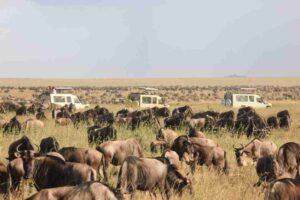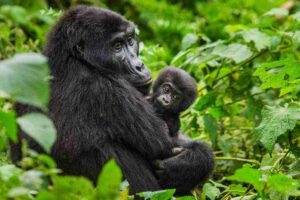| Name of the facility | Samburu Game Lodge |
|---|---|
| Certification Achieved | Silver |
| Year opened | 1990 |
| Tourism region | Laikipia/Samburu |
| County | Samburu |
| Address | P.O Box 42788 GPO – 00100 Nairobi, Kenya Map It |
| Telephone/Mobile | +254 720626366 |
| – | |
| Website | – |
| Facility Notes | Samburu Game Lodge is located within Samburu National Reserve on GPS coordinates Latitude 0.572262 || Longitude 37.53806. The lodge which is open throughout the year is owned and managed by Wilderness Lodges Limited. It occupies 20 acres of land, has 61 guest rooms with a total bed capacity of 120 and has a total of 78 permanent staff for its operations. The Samburu National Reserve is located along the banks of Ewaso Ng’iro River in Kenya bordering Buffalo Springs National Reserve to the north. It is 165 km2 in size. The river banks are covered by Acacia elatior species, Salvadora pesica bushes and Duom palms. The riverine vegetation of Ewaso Ng’iro River provides critical habitat to wildlife species in the Reserve. The reserve is rich in wildlife with an abundance of rare northern species such as the Grevy’s zebra, Somali ostrich, reticulated giraffe, gerenuk and the Beisa Oryx. The reserve has over 350 species of birds. Nile Crocodiles are common within the Ewaso Ng’iro River that cuts across the reserve. It also houses large predators such as lion, leopard, cheetah, hyena and occasionally the rare wild dog too. |
| Energy management | The Lodge has diesel run generators as the main source of energy. The facility has two (2) generators with power output of 250KvA and 230KvA. Power is used for lighting, water heating and running the lodge refrigerants. The generators are rationed for at least six hours daily. Low power output generator is run at low occupancy. Generator fuel consumption is documented on daily basis to monitor usage. Liquefied petroleum gas (LPG) is used for cooking at the guest kitchen. Water heating for guest rooms is done using diesel-run boilers which are maintained every six months. Staff and guests are sensitized on energy conservation through briefings and notices. |
| Environmental management | Samburu Game Lodge is guided by its corporate environmental policy showing commitment to environmental protection and sustainability. Further, the policy emphasizes on compliance with legal requirements, responsible resource use and engagement in corporate social responsibility. The lodge has undertaken its annual Environmental Audit (EA)in compliance with EMCA 2015 (Environmental Management and Co-ordination Act.) |
| Chemical use | The facility uses biodegradable chemicals for its laundry and swimming pool cleaning. MSDS (Material Safety Data Sheets) for the chemicals are available. Clique chemicals – biodegradable chemicals are used as bathroom amenities, soaps, lotions etc. Swimming pool chemicals consumption records are properly kept to monitor chemical use. Fuel (Diesel & Petrol) is stored in a 9000 liters tank while gas is stored in two (2) tone cylinders which are serviced and safely stored. Safety signage is available. |
| Conservation Criteria | |
| Community Criteria | |
| Solid waste management | Waste separation is conducted at source. Organic waste is composted in a well-constructed and covered pit to deter wildlife scavengers. Plastics, metallic waste (tins), glass waste are put in a waste management holding area awaiting transportation to Isiolo for recycling. The transportation company is licensed by NEMA. In addition, the facility incinerator is strictly used for paper. |
| Water management | The main source of water for Samburu Game lodge is a borehole and well located within the premises. The water is pumped and stored in reservoirs with a capacity of 100,000 liters. The water is treated through chlorination and pumped to an overhead tank with a capacity of 40,000 liters then supplied to the premises via gravity. The borehole water is metered at source and monitoring done through recording on regular basis. Visitors are sensitized on water conservation through room “towel cards” encouraging guests on the re-use of towels. Laundry machines are operated at optimum to conserve on water and enhance energy efficiency |
| Visitor communication & education | Guests are briefed upon arrival on the lodge’s operations and environmental values. |
| Pollution | The pathways are mildly lit using lanterns to reduce light pollution. Generators have a muffler (sound proofing device) installed to reduce on noise pollution. The laundry machines are automated in the amount of washing detergents/chemicals used per load which ensures the correct quantities of chemicals are in use. |
| Environmental conservation | The facility supports various conservation programs conducted within the reserves such as the Grevy’s Zebra Trust, Ewaso Lions Project and Save the Elephants. Support provided is logistical (provision of water supplies, accommodation, etc.) and participation in wildlife monitoring activities such as census and reserve clean-up activities. Samburu Game Lodge also provides logistical support to the Reticulated Giraffe Foundation. The organization’s offices are located within the lodge compound. The facility is a member of Ewaso Conservation and Tourism Forum – a group of stakeholders who work towards promoting conservation of the Ewaso River ecosystem |
| Waste water management | Effluent from the guest kitchen flows through a four (4) chamber compartment grease trap before draining into the septic tanks. Grey water effluent from the guest tents and staff quarters is managed through septic tanks. The facility swimming pool is cleaned via sieving, vacuum cleaning and backwash. Records for the swimming pool are available. Black water for the facility is managed through septic tanks. The sewer system has various manholes. The septic tanks are exhausted regularly by the county government. Effluent tests have been conducted in compliance with Environmental Management and Coordination (Water Quality) Regulations of 2006. |
| Purchasing and supplies | The facility purchases its products in bulk to reduce on packaging; fruits and vegetables are packed in re-usable crates whereas meat is packaged in cold rooms. |
| Employment and remuneration/staff welfare | Approximately 75% of the staff is employed from the local community. The employees are trained internally by the lodge management. Staff benefits include; food, uniform, transport and accommodation. The facility has a staff committee that spearheads staff welfare issues. |
| Staff education, communication and awareness training | The lodge has an in-house staff training program which is implemented at the departmental level. Sensitization is also done during weekly departmental meetings |
| Cultural preservation and promotion/protection of local sites | Cultural promotion is enhanced through the following; • Providing an avenue for cultural performances by a local troupe which are organized on demand. • Organizing manyatta visits for interested guests for cultural experiences. Cultural talks are also given by village elders. Architectural design and interior décor throughout the lodge is heavily inspired by the local Samburu culture. |
| Benefits to local community/community empowerment | The facility provides employment to the locals, as part of the lease agreement with the County government. Approximately 75% of the employees are from the local Samburu community. Additionally casuals are hired from the local community. Local purchasing is made where possible, for items such as staff meat. The facility pays lease fees and bed night fees to the County government which is included for local community projects within the county. The lodge clinic is open to the local community for a subsidized fee and in some cases, free treatment is provided. |
| Cultural Criteria | |
| Health and safety | The Lodge has a designated health and safety committee which meets on quarterly basis to spearhead health issues within the facility. 41 staff members have been trained on health and safety, conducted in October 2016. Regular in house training is conducted at departmental level including first aid training by the lodge clinical officer. The lodge has a Health Clearance Certificate from the Ministry of Public Health and Sanitation. Medical check-ups are conducted in every six (6) months to food and beverage handlers to ascertain their health fitness, and in compliance with the Food, Drugs, and Chemical substances Act. Cap 254. Other safety measures include smoke detectors fixed in guest rooms for emergency response, an emergency and fire response plan fixed in guest rooms, and fire-fighting equipment such as fire extinguishers and fire blanket in the kitchen which are strategically fixed and serviced. Further, the lodge is linked to AAR and AMREF for air emergency evacuation. Staffs are issued with Personal Protective Equipment (PPE) such as boots, gloves. |
| Child labor, abuse and human rights | The policy development is in progress |
| Business Practises Criteria | |
| Entry Date | 12th March 2018 |













